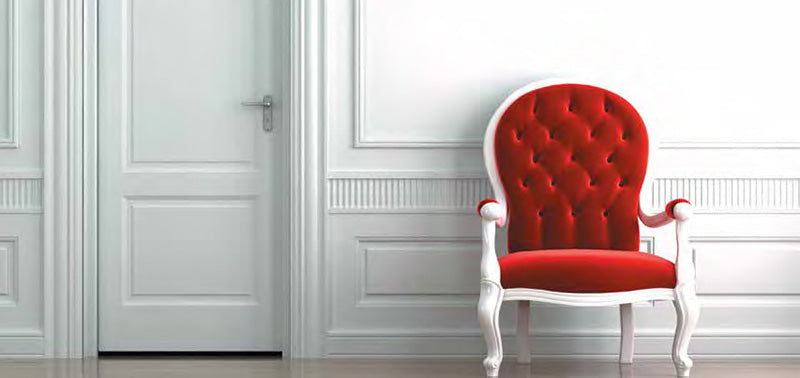
From planning and design to construction and materials, we'll walk you through every step of the process to help you replace your trim and doors.
Step 3: Meet Your Coach
Once you have your project vision, it is time to meet your Coach! Each Turkstra location has Coaches who specialize in our different product categories (gameplans), and their training is aimed at helping YOU Build-It-Better.
A meeting with your Build-It-Better Coach will focus on the details of your project, such as timing, budget, materials, style, and so much more. Proper planning and resources are critical to the success of your project, which is why we take the time to work through the details of your project together.
Below, you will find Project Information Sheets that will get you thinking about your project and some of your Coach's questions. Feel free to get a head-start before meeting with your Coach by filling out a form and bringing it to your meeting.
Door Terms
- Jamb - The vertical up-right components (or lining) that form the sides of a doorway.
- Stiles - The vertical up-right components in a door panel that form the sides and provide much of the structure in your door
- Rails - The horizontal components that are on the top and bottom of your door, these are vital structural elements of your door and if the door is to be cut down then these have to be preserved in such a way that the door is still structurally sound
- Panel - A door panel commonly refers to the profile on the surface of the door, for example a six panel door (also known as a Colonist door, though other names exist) has four equally sized rectangular boxes and two smaller square boxes routed into the surface of the door.
- Astragal - A profile of material and weather-stripping that covers the seam between doors in a two-door system
- Mullion - The term for the piece in the door between the panels, this sits inside of the rails and the styles and provides structure.
- Door Lite(s) / Glazing - The glass panel(s), or glass window(s) that are mounted inside a door.
- Sticking - The profile of the edge of the stile or rail that gives it definition and allows it to hold panels.
- Split-Jamb Pre-hung Doors - Jambs are split in half lengthwise and the trim casing is already attached to each edge of the jamb, so no mitering is necessary.
- Plumb - To determine that the jambs or casings are truly vertical, as indicated by a plumb line
- Shim - A washer or thin strip of material used to align parts, make them fit, or reduce wear (a wooden wedge in our case).
- Skin - The term for the surface of a door if it’s not made from solid wood, often these ‘skins’ are made of a plywood type material, or a hardboard type material (that can be textured with a wood grain or left smooth) and primed to a white finish
- Active Door - The door in a double-door set that is opened first and to which a functional lockset is applied.
- Transom - A mounted piece of glass or wood above the door unit. This is a decorative piece and sometimes comes with the door unit.
- Sidelite - The side panels on either side of the door. Filled with glass or wood and usually appear in pairs, though can exist solo.
- Sill / Threshold - The bottom or bottom piece of a frame. Usually made from aluminum or wood.
- Door Shoe / Door Sweep - A form of weather-stripping attached to the bottom of a door that prevents infiltration beneath the door.
- Direct Set - A type of construction for sidelites or transoms that has the glass directly mounted into the frame.
- Double Acting Door - Door which is hinged so that it can be opened both inward and outward.
- Dutch Door - A door composed of two halves, cut horizontally, that allows separate operation.
- Fiberglass Door - An alternative to wooden doors, composed of a molded fiberglass skin filled with insulating foam.
- Flush Door - A door that is designed to appear flat and does not contain any panels.
- French Door - A door with glass panes throughout its length. A French door could be a pair or not.
- Ledge Door / Batten Door - A door composed of or appears to be composed of, only vertical boards fixed by horizontal/diagonal boards.
- Paneled Door - A door composed of or appears to be composed of, stiles, rails, and panels or lites.
- Passive Door - In a door-two system, the door that typically stays closed.
- Steel Door - An alternative to wooden doors, composed of molded steel filled with insulating foam.
- Backset - The distance between the edge of the door to the center of the bore hole.
- Came, Caming - Metal stripping which is soldered at the joints, is used between cut-glass pieces to assemble the pieces into a decorative glass panel. Cames are mostly made of lead, zinc, copper, brass, or brass-capped lead.
- Distressing wood - A texturing technique that makes the wood look old or worn.
- Door Lite(s) / Glazing - The glass panel(s), or glass window(s) that are mounted inside a door.
- Door Slab - Only the door, no jamb, hinges, threshold, or door hardware.
- Door Unit - A door with a jamb, hinges, and is bored for door hardware. Exterior door units also include casing, brick molding, astragal, and weather strips and are pre-hung.
- Mortise & Tenon Joinery - A method of locking or joining / bonding two pieces of wood together through holes (mortise) and extrusions (tenon).
- Mull Post - The post between the door and sidelite is created by the door frame.
- Muntin / Uprite - A supporting vertical strip of wood or metal between panes of glass.
- Ogee - A type of sticking that is characterized by decorative curves.
- Operable Sidelite / Vented Sidelite - Sidelites that can be opened like a second door to allow airflow.
- Pre – Hung - A full door unit with the door hinged, jamb, frame, sill, and moulding.
- Prefinished - Products that are stained and sealed at the factory or warehouse before distribution.
- Primed - An undercoat that can be applied during the construction process that prepares the piece for painting.
- Rabbet - A stepped recess cut into the edge of the jamb pieces that allow them to fit at a right angle.
- Rough Opening - An opening in the wall made by standard framing materials, sized around a pre-hung unit. This is usually 2″ taller and 2″ wider than the door unit size.
- Sash In Frame - A type of construction for sidelites or transoms that has the glass held in a designed frame within the piece.
- Shaker / Square - A type of sticking that is characterized by a single right angle.
- Shim - A thin strip of material, typically wood, wedged between the jamb and the rough opening to secure and align.
- Sidelite - The side panels on either side of the door. Filled with glass or wood and usually appear in pairs, though can exist solo.
- Tempered Glass / Safety Glass - Treated glass that will crumble instead of breaking into shards.
- Transom - A mounted piece of glass or wood above the door unit. This is a decorative piece and sometimes comes with the door unit.
- Transom Lite - The glass panel(s), or glass window(s) that are mounted inside a transom.
- Trim - The covering over a door jamb gives the finished look. This is usually a strip of wood.
Window Terms
- Apron - A piece of casing or decorative trim installed against the wall immediately beneath the stool of a window.
- Brick Mould - A type of casing used for exterior doors and the exterior wall side of windows.
- Cladding - A coating or layer on a surface.
- Double Pane vs. Triple pane - Triple pane is more energy efficient than double pane and preserves the warm or cold air in your home better than double pane.
- Frame - The frame in which the your exterior door is situated.
- Jamb and Jamb Extensions - Vertical framing utilized as side posts; extensions help extend the length or depth of the jamb for varying sizes of windows.
- Nail Fin (nail flange) - A small piece of metal that is attached to the window and nailed into the frame to secure the window in position.
- Sill - The horizontal member forming the bottom of a window or exterior door frame; the lowest member of the frame of a structure, resting on the foundation and supporting the frame.
- Sash - The operating and/or stationary portion of the window unit that is separate from the frame. The sash consists of the following parts:
- Stiles: Vertical sash members.
- Rails - Horizontal sash members.
- Check Rails - Horizontal sash members that meet, as in double hung units. These could also be vertical check stiles, as in the glider or patio door.
- Bars - Divisional members extending from rail to rail or from stile to stile in an authentic divided lite unit.
- Muntins - Divisional members extending from a bar to a rail or stile or another bar.
- Weather Stripping - The process of sealing windows and doors from exterior elements with weather strips (a strip of material).
Trim Terms
- Back Band - Rabbeted moulding surrounding the outside edge of casing.
- Base - Moulding applied where floor and walls meet, forming a visual foundation.
- Base Cap - Decorative moulding installed flush against the wall and top of an S4S baseboard.
- Cased Opening - An interior opening without a door that is finished with jambs and trim.
- Casing - Moulded or surfaced-four-sided pieces of various widths and thicknesses for trimming out door and window openings.
- Corner Blocks - Square blocks used in place of mitering the sides and head casing.
- Cove - Moulding with a concave profile used at corners, particularly as a ceiling cornice.
- Chair Rail - Wooden moulding placed along the lower part of the wall to prevent damage.
- Crown - Highest part of built-in or wall, often above eye level, usually the upper trim on interior walls.
- Dentil Block - A smaller rectangle block which can be spaced closely together in a series or in sequence with moulding and projecting like teeth as used in cornice, front entrances and mantels, and crossheads.
- Door Stop - Moulding nailed to faces of the door frame to prevent the door from swinging through
- Hand Rail - Hand support in a stairwell
- Jamb - Top and two sides of a door or window frame
- Mouldings - Ornamental strips used to decorate a surface, often used to accent or emphasize the ornamentation of a structure and to conceal surface or angle joints.
- Nosing - Rounded edge of a stair step
- Panel Mold - a decorative pattern, originally used to trim out raised panel wall construction. Most useful fabricated as a frame, surrounding attractive wall coverings for a paneled effect on walls.
- Rosette/ Plinth Block - Rosette is a decorative block in the upper corner of windows and doors. Plinth is the base block which is placed on both sides of the door resting on the floor.
- Shoe Rail - Primarily used for closed stairs with a curb wall. The shoe rail sits on top of the curb wall and the balusters fit inside the shoe rail. The fillet is cut and pieced between the balusters.
- Shoe Mold - Quarter round trim applied at the bottom of baseboard where it meets the floor.
- Tongue & Groove - Lumber machined to have a groove on one side and a protruding tongue on the other side, so that pieces fit snugly together with the tongue of one fitting into the groove of the other.
- Wainscoting - Lower interior wall surface (usually 3 to 4 feet above the floor) that contrasts with the wall surface above it.
- Window Sill - Interior trim member serving as a window frame sill cap
Hardware Terms
- Active Door - The door in a double-door set that is opened first and to which a functional lockset is applied.
- Backset - The horizontal distance measured from the edge of the door to the center-point of the bore hole.
-
Backset Measurement - The door-prep image seen to the left applies to any standard tubular lock or latch set including interior door knobs, door levers, deadbolts, entry door handle set, and door handle plates.
You can see the bore hole that is 2-1/8″ in diameter. The distance from the edge of the door to the center-point of this bore hole is the backset.
Most interior doors have a 2-3/8″ backset. Most exterior doors have a 2-3/4″ backset.

- Bore - The large hole that is physically drilled through your door to allow for installation of hardware (such as a latchset like a door knob, lever, deadbolt, entry set, etc.). Bore holes are usually 2-1/8″ in diameter.
- Center-to-Center Hole Spacing - The vertical distance measured between the center-points of two bore holes. This measurement is most often needed for tubular entry door handle sets, where a bore for the deadbolt is located above the bore for the latch.
- Custom Keying - An option chosen for how we will key your door lock (such as a deadbolt, entry set, etc.). Custom keying indicates you will supply either a copy of a key or a key-code that you would like your new lock to accept.
- Cylinder - The cylindrical shaped mechanism housed within door locks that contains the tumbler and keyway, into which a key is inserted to operate the lock.

- Deadbolt - A heavy duty door lock that has no spring action, but is operated by a key or a thumb turn. Locking action will slide a metal bolt from the door deep into the door-jamb to securely lock the door. A security feature often used on exterior doors. Deadbolts are often combined with a locking knob or lever and are positioned above them on a door.
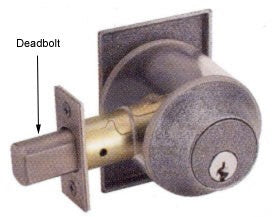
- Door Handle Plate - A large decorative plate that covers any bored hole in a door with an attached knob or lever.
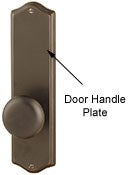
-
Door Swing - The direction the door opens while standing on the outside.
If you stand on the outside of the door and you push it away from yourself to open, it is IN-SWING. If you stand on the outside of the door and you pull it towards you to open, it is OUT-SWING. - Door Thickness - The actual measurement of the physical thickness of your door.
- Double Cylinder - Double cylinder door locks require a key to lock/unlock your door from both the outside and inside. The double cylinder function is an option for door locks like deadbolts and entry sets. Double cylinder locks are usually not recommended because they make it more difficult to exit your home in case of an emergency.

- Dummy (pair) - A dummy pair indicates a pair of handles that have no latching or locking functions. They are surface mounted to a door simply to give the door a handle to pull it open. Dummy pairs are usually used for the inactive door in a double-door set and other doors that need a handle on both sides, but no latching or locking function.

- Dummy (single) - A single dummy handle indicates one handle that has no latching or locking function. It is surface mounted to a door simply to give the door a handle to pull it open. Single dummy handles are usually used on closet doors, bifold doors, or other doors where one handle is needed, but no latching or locking function is.

- Edge Bore - The hole that is drilled into the edge of the door, connecting from the edge of the door to the larger main bore hole.
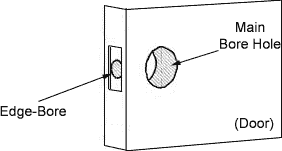
- Faceplate - Faceplate refers to the small, rectangular-shaped piece of metal that surrounds the door latch on the edge of the door.
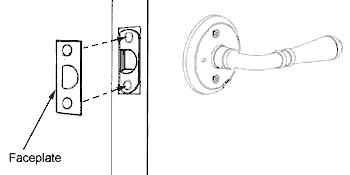
- Finish - The color of your door hardware. Most hardware has a variety of finish colors to choose from. Finish are applied as a protective coating.
- Function - The function of your door hardware refers what mechanisms are used and how they operate in your hardware. Interior hardware such as door knobs and door levers are available in passage, privacy, or dummy functions. Exterior hardware such as deadbolts and entry sets come in single-cylinder and double-cylinder functions. Door knobs and levers can also have a key-in function.
- Handing - Sometimes it is required that you know the “handing” of your door handle to indicate which direction the handle turns or operates. Handing must be determined for each door. You often will need to know handing if you are ordering a door lever, an entry door handle, or a mortise lock set. Handles are either “Left Hand” or “Right Hand.”
- To determine handing:
- 1. Stand on the outside of the door. For instance, if you are getting the handing for the front entry door of your house, stand outside of the whole house; if you are getting the handing for a bathroom door, stand outside the bathroom; for a bedroom, stand outside the bedroom; and so on.
- 2. Facing the door, see what side the hinges are located.
Left Hand = The hinges are on the left side of the door.
Right Hand = The hinges are on the right side of the door.
That’s it!! Ignore which way the door swings. - Inactive Door (in a double door) - The door in a double-door set that does not contain a latch-set, but instead is bolted at the top and bottom to hold it stationary when shut. This door receives the latch or bolt of the active door.
- Interconnect Device - A device that can be assembled into an entry set that allows you to disengage both the deadbolt and the lower latch at the same time just by operating the handle. Your door will open with this single action, as opposed to the usual two actions of first unlocking the top deadbolt before operating the handle.
- Jamb - The door frame to which the door’s hinges are attached that surrounds the door when it’s closed.
- Keyed Alike - A keying option indicating that you want ALL the cylinders in your order to operate by the same key.
- Keyed Differently - A keying option indicating that you want the cylinder for one particular door lock to operate by its own unique key.
- Keying - An option for door locks such as deadbolts or entry door handle sets used to specify how the cylinder in the lock should be keyed. Keying options are keyed alike or keyed differently.
- Key-In Knobs or Lever - Key-In Door Knobs or Door Handles Knobs or levers that contain a cylinder on the exterior side that can be locked/unlocked by a key. The interior side has a thumb turn to operate the locking function. Key-in door knobs and levers are often combined with a deadbolt installed above it for best security.

- Latch - Door Latch The beveled “tongue” spring mechanism that extends from the edge of the door into the door jamb to hold the door shut when closed.
- Mortise Lock - The most secure form of an entry set that combines the two functions of locking and latching into one large mortise lock-box. Mortise locks require special tools and door-prep methods that often must be performed by professionals. This special machining of the door allows the whole thick mortise lock-box to be installed into the door for maximum protection. Here is a sample drawing of a mortise lock-box.

- Passage (Function) - Passage Door Handle A function for interior door handles for general access doors that require a latch feature, but no locking feature. Commonly used for hallway doors, closet doors, laundry room doors, etc.

- Pocket Door - A type of door installed on a sliding track that slides into and out of a hollowed space in a wall. Any standard door can be used as a pocket door. Pocket doors are used to free up space in a room by eliminating the necessity to maintain clearance for the action of a swinging door.

- Privacy (Function) - Privacy Door Handle A function for interior door handles for use on doors of private rooms that require a latch and a simple locking feature. Commonly used for bedroom doors, bathroom doors, etc.
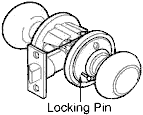
- Rosette - The decorative backplate attached to a door knob or lever that covers the bore hole in the door.

- Single Cylinder - Functional Single-cylinder door locks require a key to lock/unlock your door from the outside; and have a thumb turn mechanism on the inside to lock/unlock your door. The single-cylinder function is an option for locks such as deadbolts and entry sets. The thumb turn on the inside allows for an easy exit in case of an emergency.

- Split Finish - When the exterior portion of door hardware has a different finish color than the interior portion. To notate a split-finish, always refer to the exterior finish color first. Proper notation is as follows: Exterior Finish X Interior Finish. Example: Satin Nickel X Polished Brass – indicates the exterior finish will be Satin Nickel, and the interior finish will be Polished Brass.
- Strike plate - The metal plate installed on the door jamb that receives the latch or bolt from the door. The latch/bolt extends from the door into the strike plate.
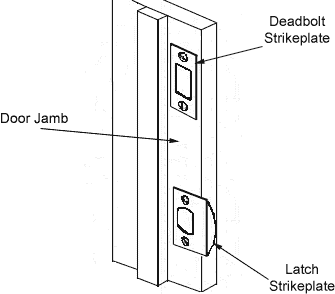
- Tubular (Lock or Latch) - Any door lock-set or latch-set that requires a bore hole and an edge-bore for installation. A standard interior door handle requires one bore hole (usually 2-1/8″ in diameter) and one edge-bore (usually 1″ in diameter). A tubular entry door handle set requires two such bores that are usually spaced either 3-5/8″ or 5-1/2″ apart from center-to-center.
Project Information Forms
Please find PDFs for our different project information categories below.
